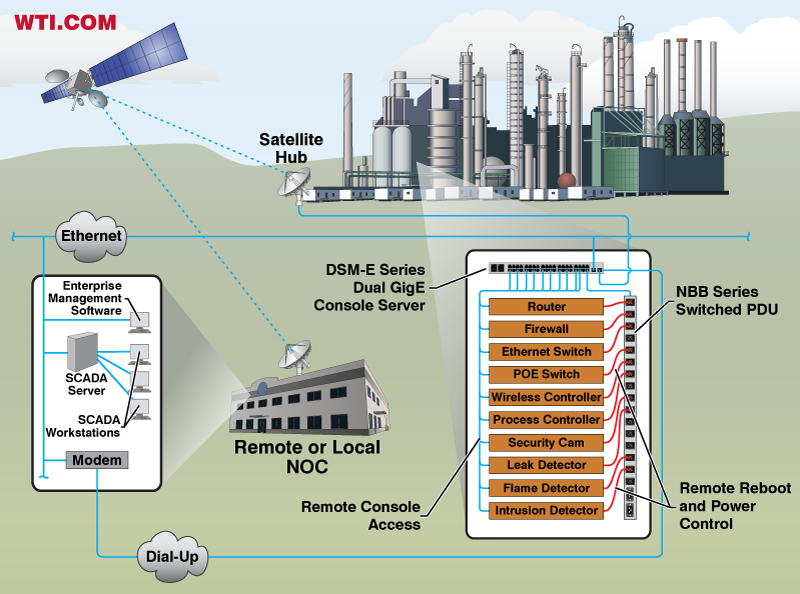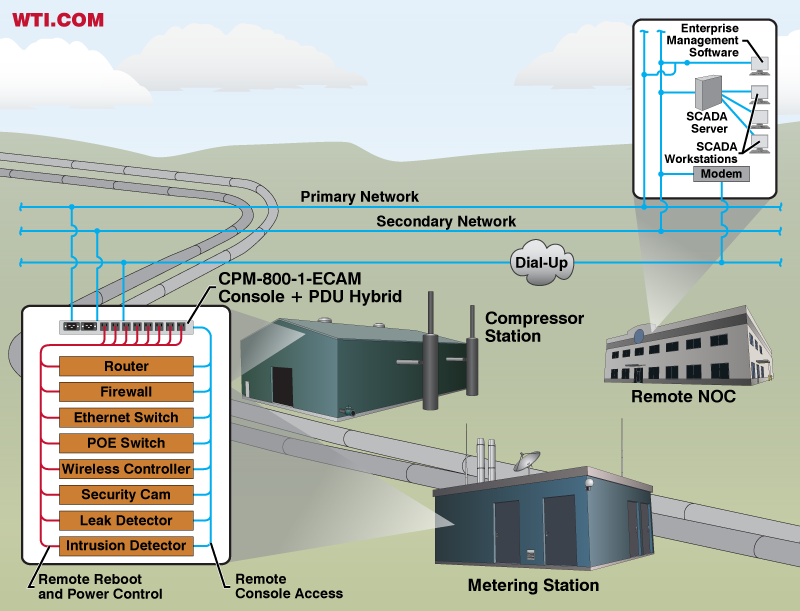Redundant Out-of-Band Communication Provides More Alternatives for Remote Access
Redundant Out-of-Band Communication Provides More Alternatives for Remote Access to Vital Devices
Challenge:
In network based applications that require prompt, uninterrupted access to vital devices and services, out-of-band communication has been widely employed to ensure that remote administrators have two separate avenues for communicating with distant network elements. When an out-of-band management solution is in place at a remote equipment site, this ensures that even when the primary, in-band means of communication is unavailable, administrators can still communicate with critical remote devices via a secondary, out-of-band channel in order to restore communication via the primary in-band channel.
This arrangement works out very well in most applications; the presence of two separate channels for management of remote devices allows administrators to deal with problems at remote sites effectively, even when communication via the primary network is not available. But there are also cases where two avenues for communication with remote devices might not be enough. This is especially true in oil and gas industry applications where even the momentary loss of services and capabilities provided by remote network elements can result in lost revenue, lapses in production and unsafe working conditions.
In order to make doubly certain that remote console access and reboot capabilities are available when needed the most, Switched PDUs and Console Servers deployed in inaccessible oil and gas industry applications need to have a third avenue for remote access. When administrators have three possible methods to access remote network management elements, this type of redundant out-of-band management provides an extra layer of reliability and helps to ensure that vital remote reboot and console access capabilities will be available when they are needed the most.
An ideal redundant out-of-band management solution for oil and gas industry applications should provide the following features:
- Dual Ethernet Ports to Allow Connection to a Secondary Network or Satellite Hub
- Internal Modem to Simplify Dial-Up Communication
- Monitoring and Alarm Capabilities to Keep Track of Conditions at Remote Network Sites
- Security and Authentication Features to Prevent Access by Unauthorized Users
- Remote Reboot and Power Switching Control
- Remote Access to Console Port Command Functions
Solution:
WTI’s CPM-800-1-ECAM Console Server + Switched PDU Hybrids and DSM-E Series Dual GigE Console Servers both feature dual Ethernet ports plus an internal modem. This provides administrators with at least three different means to access remote reboot and console access capabilities during network outages and other incidences when primary, in-band communication is not available.
The presence of a second Ethernet port plus an internal modem essentially provides redundant out-of-band management capabilities. The dual Ethernet ports can be connected to separate primary and secondary networks to provide two redundant avenues for network communication plus additional dial-up access for instances when both networks might be down. In other applications, the secondary Ethernet port can be connected to a satellite hub in order to provide communication via network, satellite and dial-up. In cases where a PSTN line is unavailable or where a fourth avenue for remote communication is needed, a 3G/4G modem can also be installed on a free serial port on the WTI Console Server to provide communication via cellular broadband.
As is the case with other crucial network operations, out-of-band management applications in the oil and gas industry need to be adequately protected from unauthorized access. With this in mind, all WTI products provide a formidable assortment of security and authentication features. A multi-level user directory allows administrators to custom tailor command privileges and access methods for each user account. In addition, support for popular authentication protocols such as Kerberos, LDAP, RADIUS and TACACS+ verifies the identity of each potential user. For applications that employ dial-up as an avenue for out-of-band communication, a novel dial-back feature provides security and authentication. Communication with WTI devices is protected by both SSHv2 encryption and an embedded FIPS 140-2 cryptographic module.
In addition to providing remote reboot and console port access, WTI products also include user-definable alarm and notification features that can immediately notify administrators and support personnel when high temperatures, excessive current consumption, power supply irregularities and other signs of trouble are detected at the remote site. In addition to the monitoring capabilities mentioned above, WTI Console Servers and Switched PDUs also include a unique ping response monitor (ping-no-answer) function that can provide immediate notification when user-selected devices cease to respond to ping commands.
When any monitored condition exceeds user-defined trigger levels WTI out-of-band management products can also immediately alert NOC personnel via email, text message or SNMP trap. In order to create an audit trail to assist in the diagnosis of recurring problems, WTI Console Servers and Switched PDUs can also compile a log that records significant events, unusual conditions and user activity.
In any critical application that demands minimal downtime and quick response to network problems, the redundant out-of-band management capabilities provided by WTI’s CPM-800-1-ECAM Console Server + Switched PDU Hybrid Units and DSM-E Series Dual GigE Console Servers can provide an additional layer of reliability to help ensure that access to critical remote reboot and console access capabilities is readily available when needed the most.
- Dual Ethernet Ports Support Multiple Connection Options
- Internal Modem with Dial-Back Authentication
- Ping-no-Answer Feature can Reboot Unresponsive Devices Automatically
- Monitor and Log Equipment Rack Conditions
- Notify Administrators and Tech Support when Potential Trouble is Detected
- Supports Popular Authentication Protocols to Verify the Identity of Each User
- Multi-Level User Directory
- Remote Reboot, Power Control and Console Access for Routers, Firewalls, Ethernet Switches, POE Switches, Wireless Controllers, Security Cams, Leak Detectors, Flame Detectors, Intrusion Detectors, Process Controllers and other Devices.
Redundant Out-of-Band Management in Refinery Applications
In refinery applications a redundant out-of-band management solution provides administrators at your NOC with reliable access to power reboot and console port command functions on networked elements located in remote or inaccessible areas of the plant. In the example shown in the illustration below, support personnel can access power reboot and console port functions at remote locations within the refinery via satellite, network or dial-up. This allows support personnel to easily reboot routers, wireless controllers, POE Switches, security and safety equipment and eliminates the need for a service call to a remote refinery and the hassles of accessing network elements buried deep in refinery infrastructure or located atop a tower or stack.

In the refinery example shown here, WTI’s DSM-E Series Dual GigE Console Server is used to provide remote access to console port command functions on up to 40 devices while WTI’s NBB series Switched PDU provides remote access to power reboot and switching functions for up to 20 devices. While the combination of the DSM-E and the NBB lends itself well to more extensive applications, where reboot and console access are required for a larger number of devices, WTI’s CPM-800-1-ECAM Console Server + Switched PDU Hybrid provides a perfect fit for smaller applications that feature fewer devices.
Redundant Out-of-Band Management in Pipeline Applications
In pipeline applications redundant out-of-band management simplifies the process of dealing with network emergencies at compressor stations, metering stations and other infrastructure spread along the pipeline route. In the example below, NOC personnel are able to access power reboot and console port functions at compressor stations and metering stations via primary network, secondary network or dial-up modem. This effectively ensures that when a router, Ethernet switch, wireless controller, security device or safety device becomes unresponsive, NOC personnel can quickly deal with the situation without the delays that inevitably occur while tech support personnel are in route to a remote pipeline site.

In this pipeline application example, WTI’s CPM-800-1-ECAM Console Server + Switched PDU Hybrid has been deployed to provide remote power switching and reboot capabilities as well as remote console access for up to eight connected devices. In larger applications, the combination of WTI’s DSM-E Series Dual GigE Console Server and NBB Series Vertical Format Switched PDU can provide console access capabilities for up to 40 connected devices, plus remote power switching and reboot control for up to 20 devices.
Results:
WTI’s CPM-800-1-ECAM Console Server + Switched PDU Hybrids and DSM-E Series Dual GigE Console Servers feature dual Ethernet ports plus an internal modem to provide redundant out-of-band management capabilities for oil and gas industry operations and other mission critical network operations. In any crucial network management application that requires constant contact with remote network elements, WTI’s Console Server and Switched PDU products can provide administrators with secure, effective remote access to power reboot and console access capabilities, helping to ensure that when a vital network element ceases to respond, normal operation can quickly be restored, reducing downtime and maximizing productivity.
Request a free demo
WTI products can be demo'd through any of the following options: